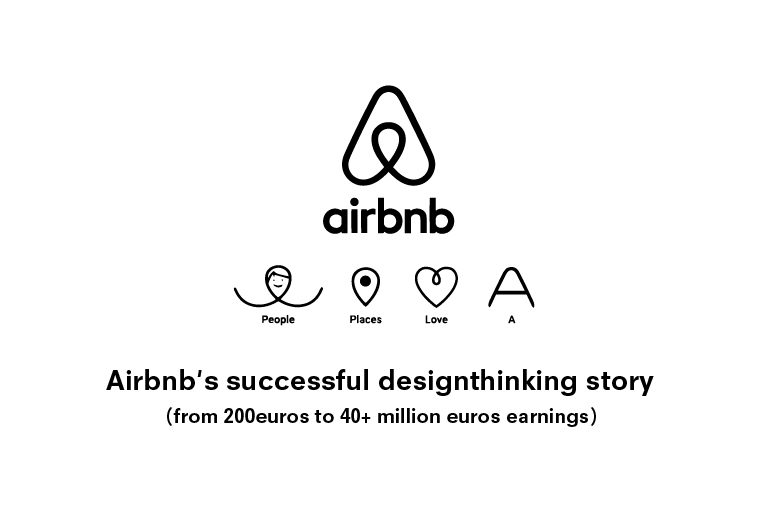Airbnb started out from the need of its co-founder to pay rent in 2008.
In 2009, what today is one of the most successful digital businesses almost crashed and burned. The young start-up then was only earning $200 per week as revenue, not enough to sustain for long. This is when Joe Gebbia, co-founder of Airbnb noticed something that changed the game for the brand. Joe noticed a pattern that all their New York listings were with poor- and low-quality images of the rooms. Making it difficult for the customers to see what they are paying for.
Paul Graham, co-founder, travelled to New York, rented a camera and visited quite a few properties to take good quality images and replace the amateur ones. The brand noticed that just by improving the quality of the images, they were able to generate $400 per week. Being a graduate from Rhode School of School, Joe had known about design thinking from school and decided to put themselves as co-founders in the shoes of the customers to understand better what the customers need.
Also read: How symbols make your design powerful
While unusual for many, this creative approach fostered a culture of holistic thinking with in-depth comprehension of what became Airbnb’s core focus- its design and user experience. Following the rules of design thinking, the co-founders turned a $400 a week revenue company into a $8.399 billion a year revenue company now present in close to 192 countries.
Empathy
With the initial success of bringing onboard high resolution and better-quality images, founders Brian and Joe dedicated a big chunk of their time to understand the needs and desires of their customer. While they saw the need for affordable, easy to access and unique travel accommodations, by talking to their customers based on what they need, they made more breakthroughs than they did by spending 4 weeks running codes behind the laptop.
What added further to the initial success here was listening to the hosts and guests feedback post the stay – and making use of this to rigorously improve their platform services – especially the concept of 11 star the brand came up with later. Empathy here towards the struggles of others was a key factor in the success of Airbnb.
Also read: What is white space in design and why is it important
Design and User Experience
Airbnb offers a website experience like no other in the travel sector. Revolutionizing the game for travel, Airbnb’s UX today is a seamless and enjoyable experience for users. The website design is user-friendly, built in a way that it’s easy to navigate and the brand invests heavily on its user research to make sure the website meets the needs of its users.
More importantly, Airbnb is mindfully designed to build trust in its users. They worked to turn the customer scare of going into a stranger’s house and staying the night into a positive data point. Airbnb built a platform of trust by including just the apt amount of information – from details of the house, the host, the area and location, its proximity to public transport and important locations to images of the entire space. The brand made sure hosts had a list of things and a length of message to offer to the customers that made them more comfortable. Their host list form was designed intuitively to build a connection that helps to increase the rate of host acceptance.
Also read: Role of a design manager in creating successful products and services
Holistic product design
Airbnb co-founder, Brian has a consumer-centric attitude that aims to look at building products with a holistic approach. This helped the brand to make their products go beyond their website or the application. It’s about building unique experiences that stay with you, your loved ones. In one of the interviews Brain mentioned this holistic product design as: “Customers are not buying our website, and they’re not buying our application. That’s just a storefront of communication. What they’re buying is a house. And frankly what they’re buying more than the house is the host, experience of hospitality & the idea of belonging.”
The application of this thought, building experiences, is what makes Airbnb stand out. Their end-to-end product design is based on offering customers an experience of their lifetime with a sense of belonging to the place. A happy environment, essentially. A product here to Brain means what goes beyond its life cycle and leads you to an Aha moment.
Five to eleven stars concept
To Brian, the five stars concept was not enough, he wanted something that goes deeper and brings out the exact thought (s) and experience of the customer.
To build meaningful connections means to ensure the customers are able to share their experiences as they were, and this means going beyond the conventional 5-star process. Airbnb offered the customers to share their end of the story exactly how it went down – almost encouraging them to share with their friends and family too. They were building something more than what people were expecting on the website, a principle they apply to almost everything at Airbnb.
Also read: The growing opportunities in motion design
Connecting design and culture
One key component in great design is to integrate your design with the culture of the place. This essentially means putting yourself in the shoes of the people using your product. The brand has worked to bring on board experiences that celebrate cities, countries, and villages in their true essence. Highlighting the communities, the tribes and the people, they offer a deep insight to the users to become a small part of one’s culture miles apart from their home.
Another way in which Airbnb does connect culture and design is reinventing and designing the space their employees work in. They do this rather interestingly by designing meeting rooms identical to the apartments of Airbnb users. Meetings rooms at the office were modelled after apartments on their websites – making them meeting rooms like homes you walk into.
Building a community
Airbnb’s focus to build a community has been its key to success. With its holistic approach, inclusivity of experiences, offering various cultural events, 5 to 11 star rating process and many other aspects, have all been to bring people together, connect them in a meaningful way and offer a sense of community to all that builds trust between hosts and guests.
In hindsight, when we take a quick glance at Couch surfing, it is another platform that aimed to offer travelers easy access and affordable accommodations in new towns and cities by hosts being able to rent out their couch for the night. What we can learn from the success of Airbnb is how the brand became revolutionary for the travel sector with their constant investment of time and capital in their user experience and website development.
Also read: How e-commerce and consumer goods brands are using multilingual design
Airbnb’s design thinking story is a well-known example of how the principles of design thinking can be applied to create successful and innovative products and services.



Want to Become a Designer ?
Strate is a unique design school that nurtures your talents as a designer by offering state-of-the art designing courses in Bangalore.
Join Strate